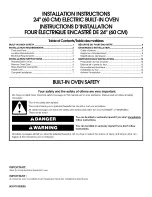
en
Cleaning agent
30
■
Unique appliance identification (consisting of
appliance codes as well as the MAC address of the
installed WiFi communication module).
■
Security certificate of the WiFi communication
module (to ensure a secure IT connection).
■
The current software and hardware version of your
domestic appliance.
■
Status of any previous resetting to factory settings.
This initial registration prepares the Home Connect
functions for use and is only required when you want to
use these Home Connect functions for the first time.
Note:
Ensure that the Home Connect functions can be
used only in conjunction with the Home Connect app.
Information on data protection can be accessed in the
Home Connect app.
D
Cleaning agent
Cleaning agent
With good care and cleaning, your appliance will retain
its appearance and remain fully functioning for a long
time to come. We will explain here how you should
correctly care for and clean your appliance.
Suitable cleaning agents
To ensure that the different surfaces are not damaged
by using the wrong cleaning agent, observe the
information in the table. Depending on the appliance
model, not all of the areas listed may be on/in your
appliance.
Caution!
Risk of surface damage
Do not use:
■
Harsh or abrasive cleaning agents,
■
Cleaning agents with a high alcohol content,
■
Hard scouring pads or cleaning sponges,
■
High-pressure cleaners or steam cleaners,
■
Special cleaners for cleaning the appliance while it is
hot.
Wash new sponge cloths thoroughly before use.
Tip:
Highly recommended cleaning and care products
can be purchased through the after-sales service.
Observe the respective manufacturer's instructions.
:
Warning – Risk of burns!
The appliance becomes very hot. Never touch the
interior surfaces of the cooking compartment or the
heating elements. Always allow the appliance to cool
down. Keep children at a safe distance.
Area
Cleaning
Appliance exterior
Stainless steel
front
Hot soapy water:
Clean with a dish cloth and then dry with a soft
cloth.
Remove flecks of limescale, grease, starch and
albumin (e.g. egg white) immediately. Corrosion
can form under such flecks.
Special stainless steel cleaning products suitable
for hot surfaces are available from our after-sales
service or from specialist retailers. Apply a very
thin layer of the cleaning product with a soft cloth.
Plastic
Hot soapy water:
Clean with a dish cloth and then dry with a soft
cloth.
Do not use glass cleaner or a glass scraper.
Painted surfaces Hot soapy water:
Clean with a dish cloth and then dry with a soft
cloth.
Control panel
Hot soapy water:
Clean with a dish cloth and dry with a soft cloth.
Do not use glass cleaner or a glass scraper.
If descaler comes into contact with the control
panel, wipe it off immediately. If you leave it, it may
stain the control panel.
Door panels
Hot soapy water:
Clean with a dish cloth and then dry with a soft
cloth.
Do not use a glass scraper or a stainless steel
scouring pad.
Door handle
Hot soapy water:
Clean with a dish cloth and then dry with a soft
cloth.
If descaler comes into contact with the door han-
dle, wipe it off immediately. Otherwise, any stains
will not be able to be removed.
Appliance interior
Enamelled sur-
faces
Hot soapy water or a vinegar solution:
Clean with a dish cloth and then dry with a soft
cloth.
Soften baked-on food remnants with a damp cloth
and soapy water. Use stainless steel wire wool or
oven cleaner to remove stubborn dirt.
Caution!
Never use oven cleaner in the cooking compart-
ment when it is still warm. This may damage the
enamel. Remove all food remnants from the cook-
ing compartment and the appliance door before
you next heat up the appliance.
Leave the cooking compartment open to dry after
cleaning it.
It is best to use the cleaning function.
"Cleaning function" on page 31
Note:
Food residues can cause white deposits to
form. These are harmless and do not affect how
the appliance works.
Remove using lemon juice if required.
Summary of Contents for HN678G4.6W
Page 2: ......
















































